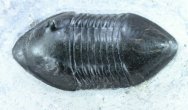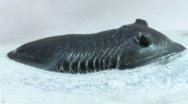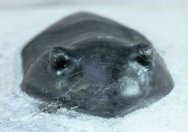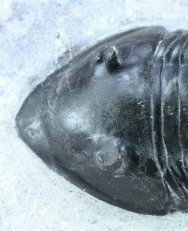Isotelus gigas
Trilobites Order
Asaphida, Superfamily Asaphoidea,
Family Asaphidae
Geological
Time: Middle Ordovician
Size (25.4
mm = 1 inch): 67 mm long by 34 mm wide on a 90 mm by 125 mm matrix
Fossil Site:
Trenton Group, Rust Formation, Spillway Member, Walcott-Rust Quarry,
New York, USA
Fossil Code:
RS154
Price: Sold
|  Description:
Isotelus gigas is an Asaphid trilobite (Order: Asaphida; Family:
Asaphidae) coming from the famous Walcott-Rust Quarry. The Walcott-Rust
Quarry was discovered in 1870 by Charles Doolittle Walcott of
Burgess Shale fame and William Palmer Rust. Many well-preserved
trilobites were found there and both Walcott and Rust sold them
to collectors and institutions. It is Walcott’s association
with Louis Agassiz of Harvard University that encouraged him
to pursue a career in academic rather than Description:
Isotelus gigas is an Asaphid trilobite (Order: Asaphida; Family:
Asaphidae) coming from the famous Walcott-Rust Quarry. The Walcott-Rust
Quarry was discovered in 1870 by Charles Doolittle Walcott of
Burgess Shale fame and William Palmer Rust. Many well-preserved
trilobites were found there and both Walcott and Rust sold them
to collectors and institutions. It is Walcott’s association
with Louis Agassiz of Harvard University that encouraged him
to pursue a career in academic rather than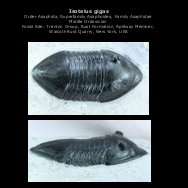 commercial paleontology.
The site was subsequently forgotten, only to be reworked by Tom
Whiteley starting in 1990. Many excellently preserved specimens
have been recovered from this site which is known as an obrution
Lagerstätte, signifying a site in which the specimens were
rapidly buried. This is a fine prone example of a trilobite whose
maximum
length exceeded 40 centimeters. It is part of a triumvirate of
huge trilobites (Isotelus gigas, Isotelus maximus & Isotelus
rex) whose largest known complete example is 70 centimeters in
length!
Isotelus
gigas
is a trilobite that undergoes ontogenic changes. As the trilobite
grows, the genal spines degenerate until mature adults have none
remaining. While the length of the genal spines varies with age,
the size at which they are lost can vary from location to location
within
the trilobite’s range. The streamlined shape is indicative
a trilobite that made its living plowing through the sediment
in search of a meal. Notice the fine pitting of the surface of
the exoskeleton. These pits are thought by some researchers to
have harbored fine sensory “hairs” which allowed
the trilobite to detect nearby predators and potential prey. commercial paleontology.
The site was subsequently forgotten, only to be reworked by Tom
Whiteley starting in 1990. Many excellently preserved specimens
have been recovered from this site which is known as an obrution
Lagerstätte, signifying a site in which the specimens were
rapidly buried. This is a fine prone example of a trilobite whose
maximum
length exceeded 40 centimeters. It is part of a triumvirate of
huge trilobites (Isotelus gigas, Isotelus maximus & Isotelus
rex) whose largest known complete example is 70 centimeters in
length!
Isotelus
gigas
is a trilobite that undergoes ontogenic changes. As the trilobite
grows, the genal spines degenerate until mature adults have none
remaining. While the length of the genal spines varies with age,
the size at which they are lost can vary from location to location
within
the trilobite’s range. The streamlined shape is indicative
a trilobite that made its living plowing through the sediment
in search of a meal. Notice the fine pitting of the surface of
the exoskeleton. These pits are thought by some researchers to
have harbored fine sensory “hairs” which allowed
the trilobite to detect nearby predators and potential prey.
|
|



